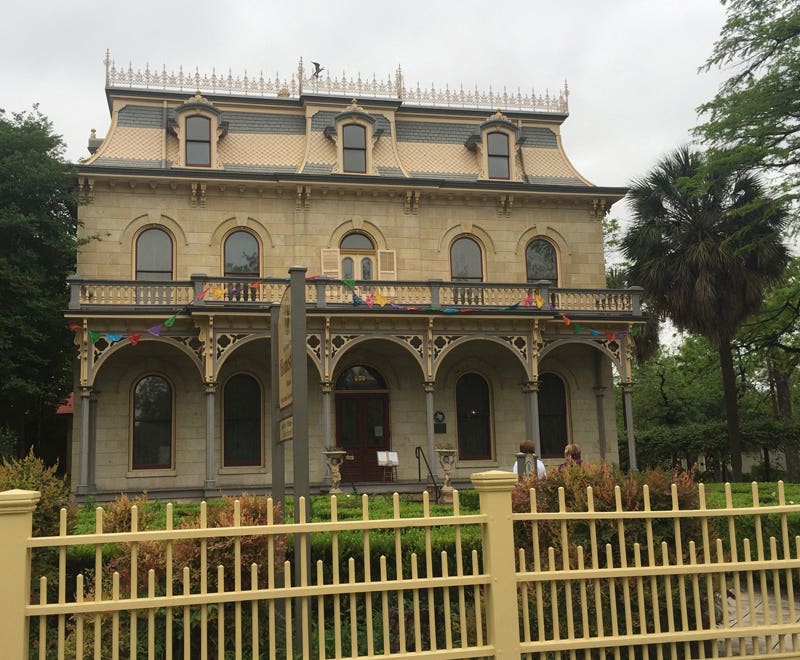
Vincent Michael
The Problem of the House Museum
Recently I gave a “Roots to Rafters” tour of our historic Steves Homestead in San Antonio, built in 1876. On this premium tour, visitors get to see attics, basements and other “Behind The Scenes” spaces. But even at twice the price, the San Antonio Conservation Society must subsidize the museum’s operation.
For well over a decade, the National Trust for Historic Preservation and others have been asking the question: Are there too many house museums? and “Why doesn’t the House Museum model work anymore?”
The answer to the first question is yes and the answer to the second is: it never did.
You don’t have to look further than the case of the Manigault House in Charleston, which was purchased by the Society for the Preservation of Old Dwellings (Preservation Society of Charleston) in 1922 to save it as a house museum. They had to buy it again two more times in the next decade. Not surprising that Charleston was the first city to adopt historic zoning, seeing the impossibility of saving buildings one by one.
William Sumner Appleton’s Society for the Preservation of New England Antiquities (Historic New England) started making house museums even earlier, but he subsidized the majority of the operating costs. In 1966, the Chicago School of Architecture Foundation purchased Henry Hobson Richardson’s Glessner House, making it rental offices as well as a museum, and started doing city tours to help pay the bills. In 1994, they jettisoned the house as an economic drain.
I think the myth of the house museum as a viable economic model came from Colonial Williamsburg, which was the number one tourist site in the United States back in the 1940s. Hundreds of local historical societies formed in the 1950s and it seems most of them saved an old house as their headquarters and museum.
Bottom line: turning a house into a museum and hoping to pay for it with admissions has never, ever worked.
Those that survive do so by 1. charging a high admission fee, like a contemporary museum; 2. having a profitable gift shop – like most of the Frank Lloyd Wright sites; 3. having an endowment; 4. being part of a larger, funded entity, like a university or state or local government; 5. diverse programming that turns the site from a museum into a community center, a place you have to visit monthly as opposed to once or twice in a lifetime.
Then there is the conservation problem: A home designed for a family or two is not well have tens of thousands of people tramping through it each year, and famed sites like Fallingwater will need a $10-$20-million rehabilitation every 20 years or so. Hundreds of small house museums have survived by deferring maintenance, fomenting an even more expensive future reckoning.
It is hard to hear it, but some historic house museums need to go back on the market as homes. They can have easements placed on them, which means they get opened to the public once or twice a year. A small house museum that gets 4,000 annual visitors only needs to be open a few days a year to meet demand.
In 1994 I was visiting Pontefract, England, and it happened to be the one day each year a site known as the Hermitage was open. Located on the grounds of a hospital, the medieval site was basically a 60-ft. spiral stone staircase underground, which while a bit claustrophobic, was a highlight of the trip, due in part to its scarcity.
The Frank Lloyd Wright Preservation Trust’s annual Wright Plus walk has been doing this for decades: charging attendees almost $100 to visit 6-9 private landmark homes that normally aren’t open to the public.
Concentrating demand and restricting supply is basic economics, and it reveals the actual economy of house museums: Yes, we want to see them but how often and at what cost?
Vincent L. Michael, PhD is an international thought leader, writer, expert consultant and speaker in heritage preservation. Now completing his 9th year as a Trustee of the National Trust for Historic Preservation, Vince served from 2012 to 2015 as Executive Director of the Global Heritage Fund in Palo Alto, California, and prior to that as John H. Bryan Chair of Historic Preservation at The School of the Art Institute of Chicago.
To find out more, you can visit his web site: www.vincemichael.com








